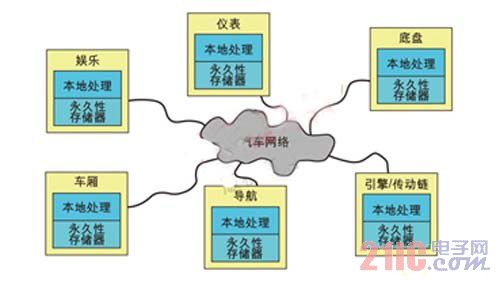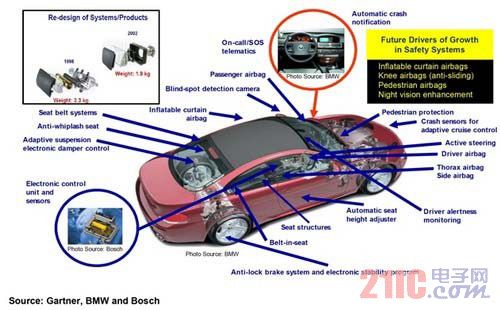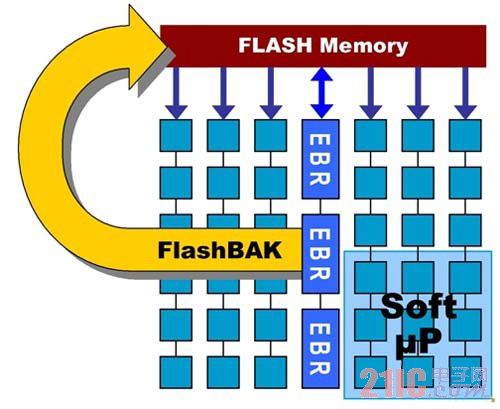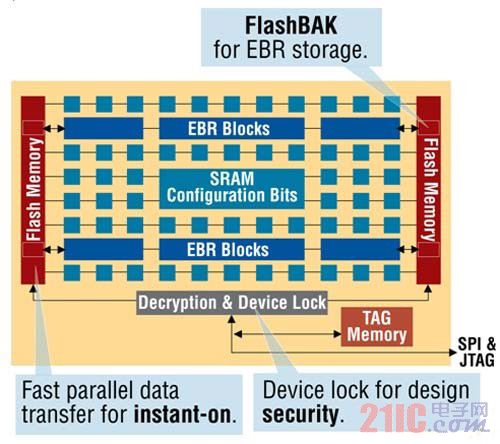Suppose you drove to a highway ramp with a sharp turn 8 months ago. Due to the speed at the turn, the car automatically takes active safety and suspension measures to avoid driving off the road.
This article refers to the address: http://
Active safety measures include automotive braking, electronic stability control and pre-tensioning of the seat belt. Smart cars can remember the active safety measures that were taken and the speed, GPS position and bearing conditions at the time.
Now suppose your spouse is driving on the aforementioned ramp, but this time it is raining. By calling the ramp position and vehicle bearing conditions that were remembered 8 months ago, and knowing the wetness of the current road conditions, the smart car can take corrective measures in advance to prevent the car from slipping out of the ramp and hitting the oncoming truck.
The above examples demonstrate the practical role of total recall: smart cars can use data from different input sources, including previous empirical data, to implement security measures, and custom applications for passengers.
Smart cars also need memory
Cars are becoming more and more intelligent. Whether it's its navigation system, entertainment system or electronic stability control and active security measures, car embedded processing capabilities have been constantly improving. According to Gartner Dataquest, the cost of electronic components will account for 30% of the cost of new vehicles by 2014, and the share of semiconductor devices will increase. Most of these automotive systems process information based on current status rather than historical data. As we can imagine, a large number of intelligent operations can be implemented using built-in permanent memory.
Today's cars generally have some type of permanent storage, but this is far from the full call feature. Persistent storage includes magnetic storage devices such as hard disks, non-volatile solid-state memories, or SRAMs that are still connected to the power supply when the car engine is turned off.
Full-featured call for customization
The biggest challenge facing designers is how to design a car that can make product differentiation with permanent storage. Customization is an area that can be fully exploited when smart cars have enough permanent storage. Customization can be used for certain user interfaces, or for applications where the user can't see them - the working state of the car.
Many custom parameters can be explicitly set by the user, such as a rear view mirror or a seat adjustment position. Other customizations may be based on experience, such as remembering dangerous road conditions or individual driving characteristics. Any experience-based customization system should allow the user to easily modify, reset or cancel the car's learning of a particular process.
Many custom settings require the electronic system to be able to identify everyone in the car so that the electronic system can provide full customization. Applications that can increase the need for permanent storage and make fully-invoking customizations include:
1. Engine and drive chain performance, including aging parameters, fuel efficiency, injection and error codes. Performance can also be personalized for each driver;
2. Passenger comfort, including remembering the seat position set by the driver or passenger, the mirror position, temperature, and even the optional dashboard display. For example, a driver may prefer to display speed on a customizable display set or head mounted display (HUD), while another driver prefers to display a clock;
3. The navigation aid system has GPS mapping of landmark points of interest. For example, display settings such as map sharpness levels or road congestion reports can be customized for each driver. Navigation can also be used to record and remind parents about their child's driving habits;
4. Active safety measures include electronic stability control and traffic signal recognition functions that provide information on traffic signals in different countries;
5. A rear seat entertainment screen with parental controls that allows viewing priority based on the content of the show and the passenger.
In a combination of the above-mentioned fields of application, active security measures initiated, for example, by electronic stability control functions, may use previously stored GPS information. Active safety procedures can only react to current data and do not process previous empirical data.
If the car design wants to take advantage of the increasing use of electronic devices each year, the capacity of the permanent memory must increase accordingly. The need to store custom setup data and information in automotive memory is becoming more and more urgent, and it must maintain its contents even when the car battery is disconnected.
Each application in a smart car contains a processing node that is connected to other processing nodes in the car. Adding available permanent storage to interconnected network nodes will form an experienced node network (Figure 1). These experience nodes allow the car to customize settings, such as processing and performing operations based on previous experience with the system.

Figure 1: Distributed use of persistent storage for experience-based customization
Full call for car safety
Garnter said that the next important growth area for automotive safety is active safety electronics. The company predicts that 50% of new cars will be equipped with Electronic Stability Control (ESC). The predictions for the Traction Control System (TCS), Brake Assist System (BA), and Adaptive Navigation Control System are also roughly the same.
It is well known that the pre-crash information available to these systems will help prevent catastrophic car accidents. Current systems may only take a fraction of a second to analyze and react to unexpected situations. Providing useful information to these systems as early as possible can make the prevention of these systems more successful. Instant information comes from sensors such as millimeter wave radar, tilt and yaw sensors, traction and drive control. Fully invoking the need to collect instant information and data from previous experiences, such as driver responsiveness and sensor and ESC motion data previously obtained at a specific GSP location and direction.
Knowing what information needs to be stored is just as important as being able to call it. It is impractical to store too much information for later use, and only important events should be stored in permanent storage.

Figure 2: Next Generation Automotive Safety Electronics
Fully invoked implementation
For large amounts of data used by entertainment systems, it may be necessary to use a hard disk as a storage medium. Other systems in the car may use non-volatile memory or SRAM with a constant power supply. Many vehicles use SRAM to save setup information such as radio station assignments, but lose all stored information when the car battery is disconnected. Permanent storage is preferably implemented in a real non-volatile memory such as flash memory.
As more and more semiconductor devices are integrated into automobiles, the amount of FPGA usage increases accordingly. FPGAs typically come with non-volatile memory, whether they are single-chip flash-based FPGAs or SRAM-based FPGA devices that use external boot memory. When the power is turned off, the SRAM-based FPGA will lose these configuration information, including any new custom data. Therefore, any newly acquired custom data must be stored off-chip.
If small size or transient start-up characteristics are a design priority, an FPGA with on-chip flash memory is a good choice. There are also FPGA devices that embed both flash and SRAM in a single chip. These devices combine the protected immediate start performance of CPLDs with the speed and capacity advantages of SRAM FPGAs. These devices do not require external memory to implement SRAM boot configuration or preload internal embedded RAM blocks (EBR). A new generation of non-volatile FPGA devices like the LatticeXP2 FPGA family has the ability to write the contents of the internal SRAM EBR memory block back to flash memory, making it the default information for the next boot of the device (Figure 3). If a soft processor is used in the FPGA, the variable information in the EBR can also be written back to the flash.

Figure 3: LatticeXP2 FPGA with flash memory that can be used to store setup information.
For SRAM-based FPGAs, SPI flash for boot programming can also be used to save custom data. Since the extra bits in the SPI memory are cheaper and do not take up extra board area, it makes sense to use SPI memory for data storage.
In order to meet automotive requirements, it is important to ensure that the FPGA is compliant with the AEC-Q100 standard and that the supplier is TS16949 certified. As with any flash device, the design must consider the number of writes supported by the device. For example, a flash memory device that guarantees a minimum of 10,000 writes can be used for more than 27 years if it is written once a day. The life of any flash device can be extended by the prudent use of flash memory.
Fast start car
As electronic systems become more complex, startup times become slower and slower. To maintain fast startup performance, non-volatile FPGAs are designed to use wide-band channels from on-chip flash memory to programmed SRAM distributed throughout the architecture (Figure 4). This solution allows the FPGA to complete the initialization boot process in about 1ms. SRAM-based FPGAs take hundreds of milliseconds to complete booting. This is important because the smart car system must complete initialization of all nodes and networks before use. Quick start is very necessary for the success of a full call.

Figure 4: FPGA device with flash writeback for fast programming and high security
Other important memory options
Other persistent storage also includes removable solid-state storage and onboard hard drives that can be used to customize applications that require high storage capacity, such as entertainment content or navigation systems. For example, you can plan your journey on a PC with powerful online point of interest search and map assistance, and then transfer the information to a car with a plug-in flash drive or Bluetooth storage device. These storage devices can also be used to store or transmit information from a car.
The methods described in this article can be used to make automotive electronic systems more customizable and more adept at using empirical data. This article recommends an experience-based customization approach and distributed persistent storage technology. The full recall function can be defined as the ability to call information from persistent storage that will act on the smart car with the current sensor input data.
Silicon Transistor are solid-state semiconductor devices with functions such as detection, rectification, amplification, switching, voltage regulation, and signal modulation. The transistor acts as a variable current switch and can control the output current based on the input voltage. Unlike ordinary mechanical switches (such as Relay and switch), transistors use electrical signals to control their opening and closing, and the switching speed can be very fast. The switching speed in the lab can reach more than 100GHz.
Silicon Transistor
Silicon Transistor, Power Transistor, IGBT Transistor, N-Channel Transistor, PNP Transistor
YANGZHOU POSITIONING TECH CO., LTD. , https://www.yzpst.com